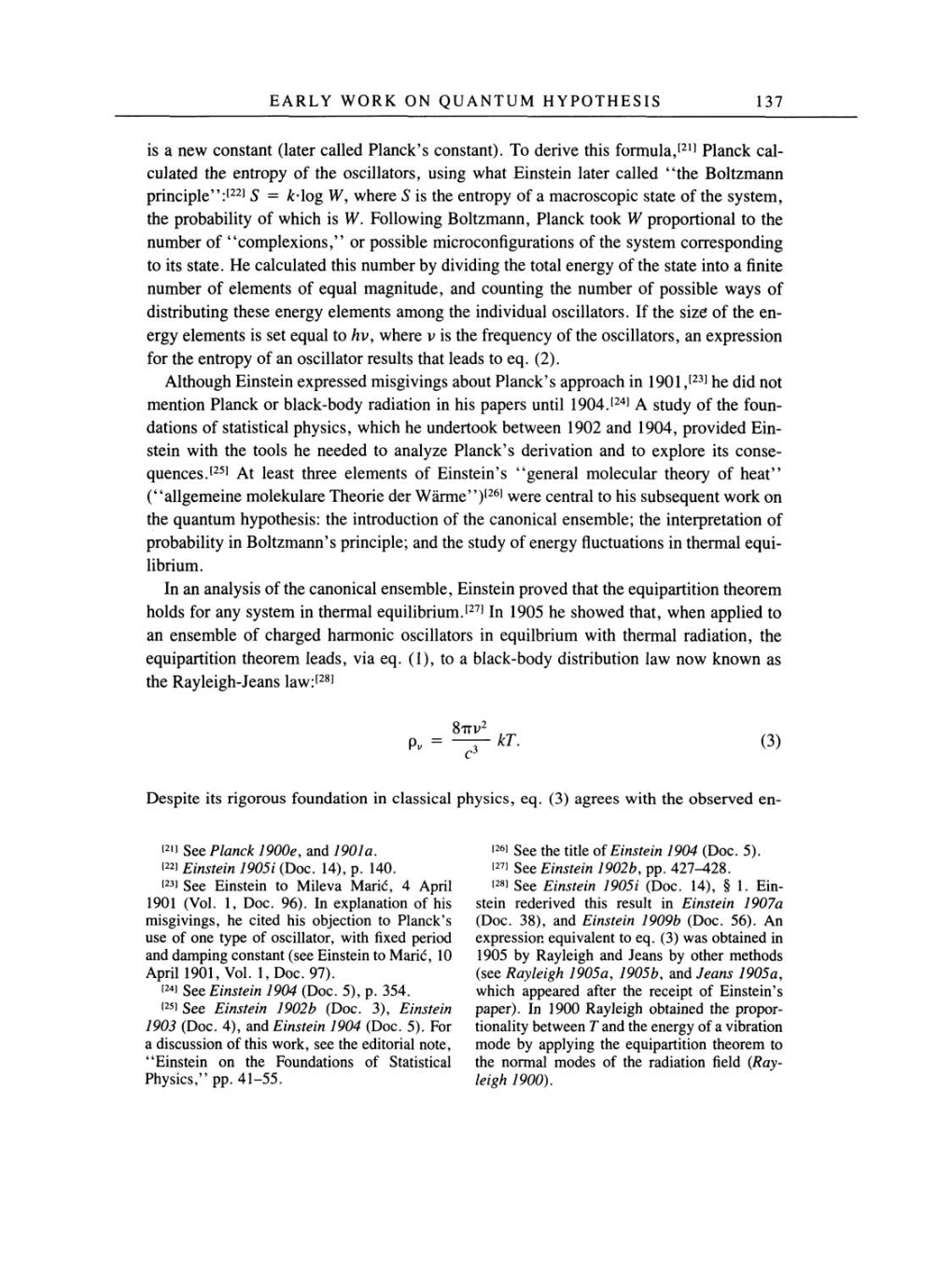EARLY WORK
ON QUANTUM
HYPOTHESIS
137
is
a new
constant
(later
called
Planck's
constant).
To derive this
formula,[21]
Planck
cal-
culated the
entropy
of
the
oscillators,
using
what Einstein later called
"the Boltzmann
principle":[22]
S
=
k.log W,
where
S is
the
entropy
of
a macroscopic
state
of
the
system,
the
probability
of
which
is W.
Following
Boltzmann,
Planck took
W proportional
to the
number
of
"complexions,"
or possible microconfigurations
of
the
system corresponding
to
its
state. He calculated this number
by
dividing
the total
energy
of
the state into
a
finite
number
of
elements of
equal magnitude,
and
counting
the
number of
possible
ways
of
distributing
these
energy
elements
among
the individual oscillators.
If
the size
of
the
en-
ergy
elements
is
set
equal
to
hv,
where
v
is
the
frequency
of
the
oscillators,
an expression
for the
entropy
of
an
oscillator results that leads to
eq. (2).
Although
Einstein
expressed misgivings
about
Planck's
approach
in
1901,[23]
he did
not
mention Planck
or black-body
radiation
in
his
papers
until
1904.[24] A
study
of
the
foun-
dations
of
statistical
physics,
which he undertook between
1902
and
1904,
provided
Ein-
stein with the tools he needed to
analyze
Planck's
derivation and to
explore
its
conse-
quences.[25]
At least three elements
of Einstein's
"general
molecular
theory
of
heat"
("allgemeine
molekulare Theorie der
Wärme")[26] were
central to his
subsequent
work
on
the
quantum
hypothesis:
the introduction
of
the canonical
ensemble;
the
interpretation
of
probability
in
Boltzmann's
principle;
and the
study
of
energy
fluctuations in thermal
equi-
librium.
In
an analysis
of
the canonical
ensemble,
Einstein
proved
that the
equipartition
theorem
holds for
any system
in
thermal
equilibrium.[27]
In
1905
he showed that, when
applied
to
an
ensemble
of
charged
harmonic oscillators
in
equilbrium
with thermal
radiation,
the
equipartition
theorem
leads,
via
eq. (1),
to
a black-body
distribution
law
now
known
as
the
Rayleigh-Jeans law:[28]
877V2
|rT,
Pv
=
--
kT.
(3)
Despite
its
rigorous
foundation in classical
physics, eq. (3) agrees
with the observed
en–
[21]
See
Planck
1900e,
and 1901a.
[22]
Einstein
1905i
(Doc. 14),
p.
140.
[23]
See Einstein to Mileva
Maric,
4
April
1901 (Vol.
1,
Doc.
96).
In
explanation
of
his
misgivings,
he cited his
objection
to
Planck's
use
of
one type
of
oscillator,
with fixed
period
and
damping
constant
(see
Einstein to
Maric,
10
April
1901,
Vol.
1,
Doc.
97).
[24]
See Einstein 1904
(Doc. 5), p.
354.
[25]
See
Einstein
1902b
(Doc. 3),
Einstein
1903
(Doc. 4),
and Einstein 1904
(Doc. 5).
For
a
discussion
of
this
work,
see
the editorial
note,
"Einstein
on
the Foundations
of
Statistical
Physics,"
pp.
41-55.
[26]
See the title
of
Einstein 1904
(Doc. 5).
[27]
See Einstein
1902b,
pp.
427-428.
[28]
See Einstein 1905i
(Doc. 14),
§
1.
Ein-
stein rederived
this
result in Einstein 1907a
(Doc.
38),
and Einstein 1909b
(Doc. 56).
An
expression
equivalent
to
eq.
(3)
was
obtained in
1905
by Rayleigh
and Jeans
by
other methods
(see
Rayleigh
1905a, 1905b,
and
Jeans
1905a,
which
appeared
after the
receipt
of Einstein's
paper).
In
1900
Rayleigh
obtained
the
propor-
tionality
between T and the
energy
of
a
vibration
mode
by applying
the
equipartition
theorem
to
the normal modes
of
the radiation field
(Ray-
leigh
1900).
